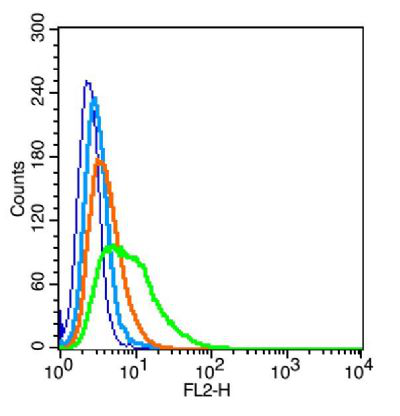产品货号 : mlR2960
英文名称 : ROM-K/Kcnj1
中文名称 : ATP调节钾离子通道ROM K抗体
别 名 : ROM K; ROM-K; inwardly rectifying subfamily J member 1; ATP regulated potassium channel ROM K; ATP sensitive inward rectifier potassium channel 1; ATP-regulated potassium channel ROM-K; ATP-sensitive inward rectifier potassium channel 1; Inward rectifier K(+) channel Kir1.1; inwardly rectifying K+ channel; IRK1_HUMAN; KCNJ 1; KCNJ; Kcnj1; Kir 1.1; Kir1.1; Potassium channel; Potassium channel inwardly rectifying subfamily J member 1; potassium inwardly-rectifying channel J1; ROMK 1; ROMK 2; ROMK; ROMK1; ROMK2.
研究领域 : 细胞生物 信号转导 通道蛋白
抗体来源 : Rabbit
克隆类型 : Polyclonal
交叉反应 : Human, Mouse, Rat, Dog, Pig, Cow, Horse, Rabbit,
产品应用 : ELISA=1:500-1000 IHC-P=1:400-800 IHC-F=1:400-800 Flow-Cyt=1ug/Test IF=1:100-500 (石蜡切片需做抗原修复)
not yet tested in other applications.
optimal dilutions/concentrations should be determined by the end user.
分 子 量 : 45kDa
细胞定位 : 细胞膜
性 状 : Lyophilized or Liquid
浓 度 : 1mg/ml
免 疫 原 : KLH conjugated synthetic peptide derived from human ROM-K/KCNJ1:301-391/391 <Cytoplasmic>
亚 型 : IgG
纯化方法 : affinity purified by Protein A
储 存 液 : 0.01M TBS(pH7.4) with 1% BSA, 0.03% Proclin300 and 50% Glycerol.
保存条件 : Store at -20 °C for one year. Avoid repeated freeze/thaw cycles. The lyophilized antibody is stable at room temperature for at least one month and for greater than a year when kept at -20°C. When reconstituted in sterile pH 7.4 0.01M PBS or diluent of antibody the antibody is stable for at least two weeks at 2-4 °C.
PubMed : PubMed
产品介绍background:
Potassium channels are present in most mammalian cells, where they participate in a wide range of physiologic responses. The protein encoded by this gene is an integral membrane protein and inward-rectifier type potassium channel. It is activated by internal ATP and probably plays an important role in potassium homeostasis. The encoded protein has a greater tendency to allow potassium to flow into a cell rather than out of a cell. Mutations in this gene have been associated with antenatal Bartter syndrome, which is characterized by salt wasting, hypokalemic alkalosis, hypercalciuria, and low blood pressure. Multiple transcript variants encoding different isoforms have been found for this gene. [provided by RefSeq, Jul 2008].
Function:
In the kidney, probably plays a major role in potassium homeostasis. Inward rectifier potassium channels are characterized by a greater tendency to allow potassium to flow into the cell rather than out of it. Their voltage dependence is regulated by the concentration of extracellular potassium; as external potassium is raised, the voltage range of the channel opening shifts to more positive voltages. The inward rectification is mainly due to the blockage of outward current by internal magnesium. This channel is activated by internal ATP and can be blocked by external barium.
Subunit:
Interacts with SGK1 and SLC9A3R2/NHERF2.
Subcellular Location:
Membrane; Multi-pass membrane protein.
Tissue Specificity:
In the kidney and pancreatic islets. Lower levels in skeletal muscle, pancreas, spleen, brain, heart and liver.
Post-translational modifications:
Phosphorylation at Ser-44 by SGK1 is necessary for its expression at the cell membrane.
DISEASE:
Defects in KCNJ1 are the cause of Bartter syndrome type 2 (BS2) [MIM:241200]; also termed hyperprostanglandin E syndrome 2. BS refers to a group of autosomal recessive disorders characterized by impaired salt reabsorption in the thick ascending loop of Henle with pronounced salt wasting, hypokalemic metabolic alkalosis, and varying degrees of hypercalciuria. BS2 is a life-threatening condition beginning in utero, with marked fetal polyuria that leads to polyhydramnios and premature delivery. Another hallmark of BS2 is a marked hypercalciuria and, as a secondary consequence, the development of nephrocalcinosis and osteopenia.
Similarity:
Belongs to the inward rectifier-type potassium channel (TC 1.A.2.1) family. KCNJ1 subfamily.
SWISS:
P48048
Gene ID:
3758
Important Note:
This product as supplied is intended for research use only, not for use in human, therapeutic or diagnostic applications.
产品图片 :












